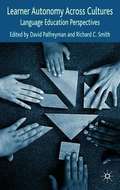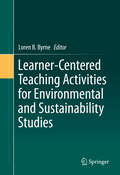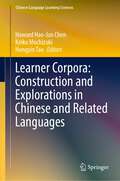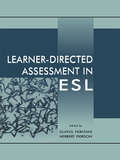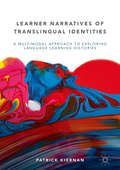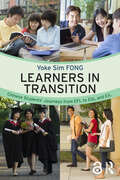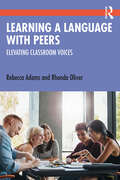- Table View
- List View
Learner Autonomy Across Cultures: Language Education Perspectives (PDF)
by David Palfreyman Richard C. SmithWhat does 'autonomy' mean within language learning? Should it be enhanced within national, institutional or small group culture and, if so, how can that be done? A variety of new theoretical perspectives are here firmly anchored in research data from projects worldwide. By foregrounding cultural issues and thus explicitly addressing the concerns of many educators on the appropriateness and feasibility of developing learner autonomy in practice, this book fills a gap in the literature and offers practical benefits to language teachers.
Learner-Centered Teaching Activities for Environmental and Sustainability Studies
by Loren B. ByrneLearner-centered teaching is a pedagogical approach that emphasizes the roles of students as participants in and drivers of their own learning. Learner-centered teaching activities go beyond traditional lecturing by helping students construct their own understanding of information, develop skills via hands-on engagement, and encourage personal reflection through metacognitive tasks. In addition, learner-centered classroom approaches may challenge students’ preconceived notions and expand their thinking by confronting them with thought-provoking statements, tasks or scenarios that cause them to pay closer attention and cognitively “see” a topic from new perspectives. Many types of pedagogy fall under the umbrella of learner-centered teaching including laboratory work, group discussions, service and project-based learning, and student-led research, among others. Unfortunately, it is often not possible to use some of these valuable methods in all course situations given constraints of money, space, instructor expertise, class-meeting and instructor preparation time, and the availability of prepared lesson plans and material. Thus, a major challenge for many instructors is how to integrate learner-centered activities widely into their courses. The broad goal of this volume is to help advance environmental education practices that help increase students’ environmental literacy. Having a diverse collection of learner-centered teaching activities is especially useful for helping students develop their environmental literacy because such approaches can help them connect more personally with the material thus increasing the chances for altering the affective and behavioral dimensions of their environmental literacy. This volume differentiates itself from others by providing a unique and diverse collection of classroom activities that can help students develop their knowledge, skills and personal views about many contemporary environmental and sustainability issues.
Learner Contributions to Language Learning: New Directions in Research
by Michael BreenSince it was first established in the 1970s the Applied Linguistics and Language Study series has become a major force in the study of practical problems in human communication and language education. Drawing extensively on empirical research and theoretical work in linguistics, sociology, psychology and education, the series explores key issues in language acquisition and language use. What the learner contributes is central to the language learning process. Learner Contributions to Language Learning provides a uniquely comprehensive account of learners' personal attributes, their thinking, their feelings, and their actions that have been shown to have an impact upon language learning.Containing specific chapters from leading names in the field, this book provides both a review of what has been discovered from previous research and identifies important future directions for research on learner contributions. It is a landmark volume setting the agenda for language learning research in the 21st century and it provides invaluable information for all those engaged in language teaching.The contributors to the volume are-Michael P. Breen Bonny NortonAnna Chamot Rebecca OxfordRod Ellis Anna PavlenkoJames P. Lantolf Anita WendenDiane Larsen-Freeman
Learner Contributions to Language Learning: New Directions in Research
by Michael BreenSince it was first established in the 1970s the Applied Linguistics and Language Study series has become a major force in the study of practical problems in human communication and language education. Drawing extensively on empirical research and theoretical work in linguistics, sociology, psychology and education, the series explores key issues in language acquisition and language use. What the learner contributes is central to the language learning process. Learner Contributions to Language Learning provides a uniquely comprehensive account of learners' personal attributes, their thinking, their feelings, and their actions that have been shown to have an impact upon language learning.Containing specific chapters from leading names in the field, this book provides both a review of what has been discovered from previous research and identifies important future directions for research on learner contributions. It is a landmark volume setting the agenda for language learning research in the 21st century and it provides invaluable information for all those engaged in language teaching.The contributors to the volume are-Michael P. Breen Bonny NortonAnna Chamot Rebecca OxfordRod Ellis Anna PavlenkoJames P. Lantolf Anita WendenDiane Larsen-Freeman
Learner Corpora: Construction and Explorations in Chinese and Related Languages (Chinese Language Learning Sciences)
by Howard Hao-Jan Chen Keiko Mochizuki Hongyin TaoThis edited book reflects the state of the art in learner corpus and related approaches to Chinese as a second language (CSL). CSL as a field has flourished in the past few decades due to the increasingly important role of the Chinese language at the world stage, yet studies of Chinese as a second language based on learner corpora have been less well developed due to the limited availability of data and lack of theoretical insights. This book represents the latest research in this area by 1) assembling a large group of active researchers from multiple international research communities (USA, China, Hong Kong, Macau, Japan, Taiwan, and France); 2) discussing the latest resources and technologies in Chinese and other Asian languages learner corpora and corpus building; 3) basing Chinese as a second language studies on data from learners of Chinese with a wide range of first language backgrounds (English, Japanese, Korean, French, among others); and 4) integrating corpus methods with a wide range of related methods in allied fields—language acquisition, usage-based linguistics, psycholinguistics, and neurolinguistics. This comprehensive collection is indispensable for anyone who is interested in corpus approaches to CSL and Chinese applied language studies in general.
Learner Corpus Research: New Perspectives and Applications (Corpus and Discourse)
by Anthony McEnery Dana Gablasova Vaclav Brezina Lynne FlowerdewThis volume showcases original, agenda-setting studies in the field of learner corpus research of both spoken and written production. The studies have important applications for classroom pedagogy. The volume brings readers up-to-date with new written and spoken learner corpora, often looking at previously under-examined variables in learner corpus investigations. It also demonstrates innovative applications of learner corpus findings, addressing issues such as the effect of task, the effect of learner variables and the nature of learner language. The volume is of significant interest to researchers working in corpus linguistics, learner corpus research, second language acquisition and English for Academic and Specific Purposes, as well to practitioners interested in the application of the findings in language teaching and assessment.
Learner Corpus Research: New Perspectives and Applications (Corpus and Discourse)
by Anthony McEnery Dana Gablasova Vaclav Brezina Lynne FlowerdewThis volume showcases original, agenda-setting studies in the field of learner corpus research of both spoken and written production. The studies have important applications for classroom pedagogy. The volume brings readers up-to-date with new written and spoken learner corpora, often looking at previously under-examined variables in learner corpus investigations. It also demonstrates innovative applications of learner corpus findings, addressing issues such as the effect of task, the effect of learner variables and the nature of learner language. The volume is of significant interest to researchers working in corpus linguistics, learner corpus research, second language acquisition and English for Academic and Specific Purposes, as well to practitioners interested in the application of the findings in language teaching and assessment.
Learner-directed Assessment in Esl
by Glayol V. Ekbatani Herbert D. PiersonThis text integrates the theory and practice of learner-based assessment. Written in response to two recent movements in language teaching--learner-centered teaching and a renewed interest in authenticity in language testing--it examines the relationship between the language learner and language assessment processes, and promotes approaches to assessment that involve the learner in the testing process. Particular attention is given to issues of reliability and validity. Grounded in current pedagogical applications of authentic assessment measures, this volume is intended for and eminently accessible to classroom teachers and program directors looking for ways to include their students in the evaluation process, graduate students, and professional language testers seeking authenticity in assessment and desiring to create more interactive evaluation tools.
Learner-directed Assessment in Esl
by Glayol V. Ekbatani Herbert D. PiersonThis text integrates the theory and practice of learner-based assessment. Written in response to two recent movements in language teaching--learner-centered teaching and a renewed interest in authenticity in language testing--it examines the relationship between the language learner and language assessment processes, and promotes approaches to assessment that involve the learner in the testing process. Particular attention is given to issues of reliability and validity. Grounded in current pedagogical applications of authentic assessment measures, this volume is intended for and eminently accessible to classroom teachers and program directors looking for ways to include their students in the evaluation process, graduate students, and professional language testers seeking authenticity in assessment and desiring to create more interactive evaluation tools.
Learner English on Computer (Studies in Language and Linguistics)
by Geoffrey Leech Sylviane GrangerThe first book of its kind, Learner English on Computer is intended to provide linguists, students of linguistics and modern languages, and ELT professionals with a highly accessible and comprehensive introduction to the new and rapidly-expanding field of corpus-based research into learner language. Edited by the founder and co-ordinator of the International Corpus of Learner English (ICLE), the book contains articles on all aspects of corpus compilation, design and analysis.The book is divided into three main sections; in Part I, the first chapter provides the reader with an overview of the field, explaining links with corpus and applied linguistics, second language acquisition and ELT. The second chapter reviews the software tools which are currently available for analysing learner language and contains useful examples of how they can be used. Part 2 contains eight case studies in which computer learner corpora are analysed for various lexical, discourse and grammatical features. The articles contain a wide range of methodologies with broad general application. The chapters in Part 3 look at how Computer Learner Corpus (CLC) based studies can help improve pedagogical tools: EFL grammars, dictionaries, writing textbooks and electronic tools. Implications for classroom methodology are also discussed.The comprehensive scope of this volume should be invaluable to applied linguists and corpus linguists as well as to would-be learner corpus builders and analysts who wish to discover more about a new, exciting and fast-growing field of research.
Learner English on Computer (Studies in Language and Linguistics)
by Geoffrey Leech Sylviane GrangerThe first book of its kind, Learner English on Computer is intended to provide linguists, students of linguistics and modern languages, and ELT professionals with a highly accessible and comprehensive introduction to the new and rapidly-expanding field of corpus-based research into learner language. Edited by the founder and co-ordinator of the International Corpus of Learner English (ICLE), the book contains articles on all aspects of corpus compilation, design and analysis.The book is divided into three main sections; in Part I, the first chapter provides the reader with an overview of the field, explaining links with corpus and applied linguistics, second language acquisition and ELT. The second chapter reviews the software tools which are currently available for analysing learner language and contains useful examples of how they can be used. Part 2 contains eight case studies in which computer learner corpora are analysed for various lexical, discourse and grammatical features. The articles contain a wide range of methodologies with broad general application. The chapters in Part 3 look at how Computer Learner Corpus (CLC) based studies can help improve pedagogical tools: EFL grammars, dictionaries, writing textbooks and electronic tools. Implications for classroom methodology are also discussed.The comprehensive scope of this volume should be invaluable to applied linguists and corpus linguists as well as to would-be learner corpus builders and analysts who wish to discover more about a new, exciting and fast-growing field of research.
Learner English: A Teacher's Guide to Interference and Other Problems (Second Edition) (PDF)
by Michael Swan Bernard SmithThis updated edition is a practical reference guide which compares the relevant features of a student's own language with English, helping teachers to predict and understand the problems their students have. Learner English has chapters focusing on major problems of pronunciation, grammar, vocabulary and other errors as well as new chapters covering Korean, Malay/Indonesian and Polish language backgrounds.
Learner Identity and Learner Beliefs in EFL Writing (Second Language Learning and Teaching)
by Olga MajchrzakThis book focuses on the concept of learner writer identity in the context of foreign language writing. The author demonstrates that the process of writing in a foreign language is much more complex and personal than many writing instructors may assume. The book’s theoretical chapters address such concepts as bilingualism, the process of L2 writing, and identity in L2 writing. The book’s empirical section discusses the students’ views on writing in L1 and in L2, the students’ writing processes in both languages, and the students’ identities in L1 and L2 writing. It is shown that writing in L2 poses problems of a linguistic nature; however, for the advanced EFL learners writing in L2 also creates opportunities they would never have when composing in their mother tongue.
Learner Narratives of Translingual Identities: A Multimodal Approach to Exploring Language Learning Histories
by Patrick KiernanThis book addresses translingual identities through an innovative multimodal analysis of the language learning histories of a class of advanced learners of English in Japan who grew up between two or more languages. The author explores both the translingual experiences of those in the classroom and how they use language and gesture when describing their experiences to each other. This approach uses three perspectives: it looks at the worlds and identities the interviewees construct for themselves; at their interpersonal communication; and at the way they frame their experience. Finally, it offers some lessons based on the observations of the class which reveal the values they share and the key to their success as language learners. It will appeal to applied linguistic and educational researchers, particularly those with an interest in narrative approaches to exploring educational contexts, as well as language educators and policy makers interested in gaining a learner perspective on language learning.
Learner Narratives of Translingual Identities: A Multimodal Approach to Exploring Language Learning Histories
by Patrick KiernanThis book addresses translingual identities through an innovative multimodal analysis of the language learning histories of a class of advanced learners of English in Japan who grew up between two or more languages. The author explores both the translingual experiences of those in the classroom and how they use language and gesture when describing their experiences to each other. This approach uses three perspectives: it looks at the worlds and identities the interviewees construct for themselves; at their interpersonal communication; and at the way they frame their experience. Finally, it offers some lessons based on the observations of the class which reveal the values they share and the key to their success as language learners. It will appeal to applied linguistic and educational researchers, particularly those with an interest in narrative approaches to exploring educational contexts, as well as language educators and policy makers interested in gaining a learner perspective on language learning.
Learners in Japanese Language Classrooms: Overt and Covert Participation
by Reiko YoshidaThe verbal participation of learners in language classrooms offers a rich seam of data to the applied linguist. Overt and covert participation, when examined, can reveal both the structures of a classroom and elicit privileged information on participant's self-perceptions. It examines the verbal participation of learners in Japanese as a Foreign Language classrooms. Verbal interactions with teachers and classmates and 'private' speech acts are examined in relation to the classroom context and also sociocultural factors such as the learner's motivation and the teacher's belief in their own methods.The examination of corrective feedback episodes and learners' private speech uses recorded speech and stimulated recall interviews recorded over the period of a year. The main focus is on Corrective Feedback episodes, and explains not only the language used in class but also teacher's and learner's own perceptions. It will be of interest to researchers in applied linguistics and second language acquisition, especially those involved with Japanese as a second or other language.
Learners in Japanese Language Classrooms: Overt and Covert Participation
by Reiko YoshidaThe verbal participation of learners in language classrooms offers a rich seam of data to the applied linguist. Overt and covert participation, when examined, can reveal both the structures of a classroom and elicit privileged information on participant's self-perceptions. It examines the verbal participation of learners in Japanese as a Foreign Language classrooms. Verbal interactions with teachers and classmates and 'private' speech acts are examined in relation to the classroom context and also sociocultural factors such as the learner's motivation and the teacher's belief in their own methods.The examination of corrective feedback episodes and learners' private speech uses recorded speech and stimulated recall interviews recorded over the period of a year. The main focus is on Corrective Feedback episodes, and explains not only the language used in class but also teacher's and learner's own perceptions. It will be of interest to researchers in applied linguistics and second language acquisition, especially those involved with Japanese as a second or other language.
Learners in Transition: Chinese Students’ Journeys from EFL to ESL and EIL
by Yoke Sim FongAs the number of Chinese students learning English increases worldwide, the need for teachers to understand the characteristics and challenges facing this group of learners grows. This is particularly true for those students moving from an English as a Foreign Language context to an English as a Second Language/International Language one where they experience academic, linguistic and sociocultural transitions. Drawing on over 20 years’ experience teaching English courses to Chinese learners, the author aims to highlight key findings to aid understanding, improve teachers’ practice and offer pedagogical recommendations. Using students’ voices, the book covers: how the traditional Chinese culture of learning plays a role; how new learning contexts provide opportunities and empowerment; how learners’ beliefs and strategies are interconnected; how their motivation and identity underscore the power of real and imagined communities, and finally, that affect matters, showing how learners are propelled by the trajectory of their emotions. The book cites from the rich data collected over a five-year period to authenticate the findings and recommendations but also to give voice to this group of learners to challenge the stereotype of the passive "Chinese learner". The essential insights contained within are useful for pre- and in-service teachers of English and researchers interested in language education around the world.
Learners in Transition: Chinese Students’ Journeys from EFL to ESL and EIL
by Yoke Sim FongAs the number of Chinese students learning English increases worldwide, the need for teachers to understand the characteristics and challenges facing this group of learners grows. This is particularly true for those students moving from an English as a Foreign Language context to an English as a Second Language/International Language one where they experience academic, linguistic and sociocultural transitions. Drawing on over 20 years’ experience teaching English courses to Chinese learners, the author aims to highlight key findings to aid understanding, improve teachers’ practice and offer pedagogical recommendations. Using students’ voices, the book covers: how the traditional Chinese culture of learning plays a role; how new learning contexts provide opportunities and empowerment; how learners’ beliefs and strategies are interconnected; how their motivation and identity underscore the power of real and imagined communities, and finally, that affect matters, showing how learners are propelled by the trajectory of their emotions. The book cites from the rich data collected over a five-year period to authenticate the findings and recommendations but also to give voice to this group of learners to challenge the stereotype of the passive "Chinese learner". The essential insights contained within are useful for pre- and in-service teachers of English and researchers interested in language education around the world.
Learning a Language with Peers: Elevating Classroom Voices
by Rebecca Adams Rhonda OliverDrawing on experiences of ESOL teachers from around the world, this book provides insights into how peer learning is understood and used in real language classrooms. Based on survey responses, interviews, and observations in a wide range of classroom settings, this book integrates research on peer interaction in second language learning from cognitive and social frameworks with original data on teacher beliefs and practices around the use of peer learning in their teaching. Readers will gain understanding, through teachers' own words, of how peer interaction is used to teach linguistic form, how learners collaborate to develop oral and written communication skills, and how technology is used with peer learning. This book also delineates the ways that current second language peer interaction research diverges from classroom practice and concludes with a classroom-centered research agenda that addresses the nexus of research and practice on second language peer interaction. The book provides a template for integrating research- and practice-based perspectives on second language learning. Language teachers, teacher educators, second language researchers, and advanced students of applied linguistics, SLA, TESOL, and language pedagogy will benefit from this volume’s perspective and unique work.
Learning a Language with Peers: Elevating Classroom Voices
by Rebecca Adams Rhonda OliverDrawing on experiences of ESOL teachers from around the world, this book provides insights into how peer learning is understood and used in real language classrooms. Based on survey responses, interviews, and observations in a wide range of classroom settings, this book integrates research on peer interaction in second language learning from cognitive and social frameworks with original data on teacher beliefs and practices around the use of peer learning in their teaching. Readers will gain understanding, through teachers' own words, of how peer interaction is used to teach linguistic form, how learners collaborate to develop oral and written communication skills, and how technology is used with peer learning. This book also delineates the ways that current second language peer interaction research diverges from classroom practice and concludes with a classroom-centered research agenda that addresses the nexus of research and practice on second language peer interaction. The book provides a template for integrating research- and practice-based perspectives on second language learning. Language teachers, teacher educators, second language researchers, and advanced students of applied linguistics, SLA, TESOL, and language pedagogy will benefit from this volume’s perspective and unique work.
Learning about Linguistics (Routledge Library Editions: Linguistics)
by F.C. Stork J.D.A. WiddowsonThis book offers a workbook approach to linguistics and provides guidelines for the study of language. It aims to give basic information and to indicate something of the background and development of the more important trends in the subject. Each chapter includes exercises which lead the reader outwards from the information given in the text. A list of suggested further reading and references follows each chapter so that each aspect of the subject may be followed up in greater depth if so desired. The book will be of particular use to first-year university students and to students in polytechnics, technical colleges, colleges of education and further education, and, the authors also hope, to many sixth-formers in secondary schools. It will also be of interest to the general reader who wishes to learn about linguistics.
Learning about Linguistics: Linguistics: Learning About Linguistics (Routledge Library Editions: Linguistics)
by F.C. Stork J.D.A. WiddowsonThis book offers a workbook approach to linguistics and provides guidelines for the study of language. It aims to give basic information and to indicate something of the background and development of the more important trends in the subject. Each chapter includes exercises which lead the reader outwards from the information given in the text. A list of suggested further reading and references follows each chapter so that each aspect of the subject may be followed up in greater depth if so desired. The book will be of particular use to first-year university students and to students in polytechnics, technical colleges, colleges of education and further education, and, the authors also hope, to many sixth-formers in secondary schools. It will also be of interest to the general reader who wishes to learn about linguistics.
Learning About Particles - 50 Privileged Years
by Jack SteinbergerVividly and in some depth retraces the golden years of particle physics as witnessed by one of the scientists who made seminal contributions to the understanding of what is now known as the Standard Model of particle physics. It will provide the interested reader with a first-hand account and deeper understanding of the multilayered and sinous development that finally led to the present architecture of this theory. Combines particle physics with insightful stories about fellow physicists of some note and the political turmoil of his times.
Learning Alsatian through English: A Comparative Dictionary--English - German - Alsatian - French--for English Speakers
by NA NAA new comparative reference guide for English speaking learners of Alsatian German. This comparative multilingual dictionary is based on the main similarities between the two languages and will show how English speakers can take advantage of the resources of English and thus learn basic Alsatian through English. Owing to striking similarities between Alsatian and English, English speakers can put their knowledge of everyday Englishto good use when learning basic Alsatian.
